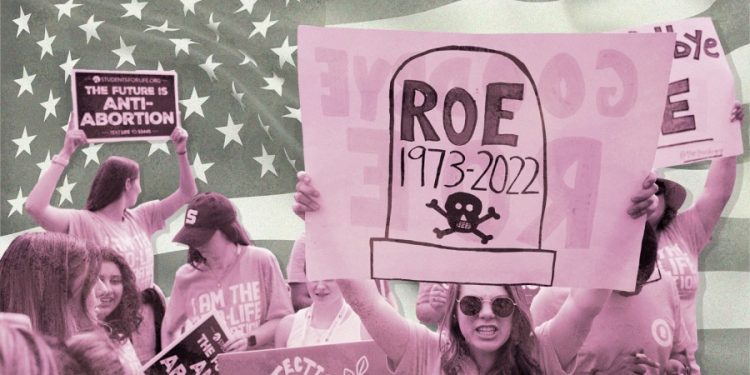This is first story in a series examining the impact of the fall of Roe v. Wade with the Supreme Court’s ruling last June in Dobbs v. Jackson Women’s Health Organization.
Almost exactly a year ago, a Supreme Court ruling ended the constitutional right to an abortion, allowing states to make their own policies.
The decision was part of a sharp rightward turn for the court after conservatives cemented a six-vote supermajority when Amy Coney Barrett replaced Ruth Bader Ginsburg.
The court’s majority opinion in Dobbs v. Jackson Women’s Health Organization, issued June 24, 2022, halted a 50-year precedent of federal abortion protections and marked the start of a new era in abortion politics.
Democrats and people who have supported abortion rights suddenly found themselves on the defensive. They became more energized in efforts to strengthen abortion protections where they already existed and to keep them from eroding elsewhere.
Anti-abortion groups, meanwhile, celebrated a win that had been years in the making. Almost immediately, a cascade of so-called “trigger laws” — written to prohibit abortion as soon as Roe v. Wade was overturned — began to take effect in more than a dozen states.
For thousands of people, new restrictions meant they no longer could obtain an abortion in their home state or even nearby.
According to a report from the Society of Family Planning, a group of health professionals that promotes research on abortion and contraception, there were 2,849 fewer abortions per month in the nine months post-Dobbs than if the pre-Dobbs rate from April and May 2022 stayed the same.
Nationally, there were an average of 79,031 abortions per month in the nine months post-Dobbs, compared to 81,730 in the pre-Dobbs months.
State abortion laws in flux
Now, abortion is almost completely banned in 14 states, and there are gestational limits in a handful of others. The patchwork of state laws has led to a confusing landscape that’s constantly changing as challenges take place in courtrooms across the country.
Rachel Rebouché, dean of the Temple University Beasley School of Law, said it’s no surprise that laws are in flux. The Dobbs decision thrust state-level courts into positions of needing answers to questions they haven’t had to consider in decades, and it forced providers to parse language to figure out whether long-standing practices were suddenly illegal.
“The change was fast, and it wasn’t accompanied with guidance. What is this? How do we interpret a life exception? Does a health exception in the law include mental health, physical health? How should physicians speak about miscarriage treatment differently than a state abortion ban?” Rebouché said.
Wisconsin, for example, was one of the states with a law on the books that completely outlawed abortion should Roe be overturned. The 174-year-old law remains in effect, even as the state’s Democratic Gov. Tony Evers and Attorney General Josh Kaul filed a lawsuit to try to block it.
The newly liberal-controlled Wisconsin Supreme Court is expected to decide the case. Until it does, abortion is illegal in the state.
Kristen Lyerly, an OB-GYN and abortion care provider, said she lives in Wisconsin but no longer practices there. She works in Minnesota, where Gov. Tim Walz (D) enshrined the right to abortion and other reproductive health care into state law.
“When the Dobbs decision came down, we immediately stopped providing abortion care. In the clinics in Milwaukee and Madison, they had to send the people home who had been scheduled that day and were waiting for their procedures,” Lyerly said.
Lyerly, a member of the Committee to Protect Health Care, said she has seen providers become more outspoken about the medical aspect of abortion and wants to continue that push.
“We’ve taken abortion and we’ve stigmatized it, we’ve put it in separate clinics, we’ve taken it out of the health care realm,” Lyerly said.
“It never should have been isolated because abortion care is integrated into many fundamental aspects of women’s health care; miscarriage management, infertility treatment, navigating complicated pregnancies. It is just so interwoven with the general care that we provide our patients that it should never have been removed,” Lyerly said.
State court battles
Rebouché said state constitutions largely have more robust rights to privacy, equality and bodily autonomy than the U.S. Constitution.
In South Carolina, for example, the state Supreme Court in January overturned a 2021 six-week abortion ban as an “unreasonable restriction upon a woman’s right to privacy.”
Republicans in the House and Senate passed a bill in late May blocking the procedure after an ultrasound detects cardiac activity, which is usually at about six weeks.
Gov. Henry McMaster (R) signed the bill two days after it passed the Senate. But barely 24 hours later, a judge granted a temporary injunction blocking the law until it can be reviewed by the state Supreme Court.
For now, abortion is legal until 22 weeks of pregnancy.
The law includes some specific changes lawmakers said were designed to pass muster with the court. In addition, January’s 3-2 decision to block the six-week ban was written by the court’s only female justice, who retired shortly after the ruling when she reached mandatory retirement age.
The legislature replaced her with a man, who has the support of the state’s ultra-conservative Freedom Caucus.
Public opinion divided on abortion
Even as more states work to pass abortion restrictions and anti-abortion advocates press lawmakers to take a hard-line position, there’s a growing divide between public opinion and longtime GOP goals on abortion.
The political concerns have been on stark display nationally among Republican presidential hopefuls.
Some in GOP leadership have been encouraging a messaging reset on abortion, and anti-abortion advocates are calling out lawmakers for not pushing back hard enough on Democratic attacks.
Katie Glenn Daniel, state policy director for Susan B. Anthony Pro-Life America (SBA), said the 2022 election shows Republican governors can run on a strong anti-abortion record.
“Voters in November of 2022 reelected and increased majorities for pro-life lawmakers in the states like Florida, Georgia, Iowa. These are states where you have a governor running on their record of being pro-life, winning, expanding their margins,” Glenn Daniel said.
But Republicans perhaps did not anticipate how voters would react when presented with an opportunity to directly weigh in on abortion rights. Every state that put abortion on the ballot in 2022 voted in favor of protecting access to the procedure in some way, including Republican-leaning Kentucky and Kansas.
The fight over abortion also played a salient role in the Wisconsin Supreme Court race. Milwaukee County Judge Janet Protasiewicz, who publicized her support for abortion access, won the open seat and flipped the high court’s conservative majority for the first time in 15 years.
New data from Gallup shows that since the ending of Roe v. Wade, public support for abortion rights continues to grow. Only 13 percent of Americans believe abortion should be illegal under all circumstances — a meaningful decline from just four years ago, when a Gallup poll found 21 percent supported a total ban.
Before the Dobbs ruling, polls showed Americans’ support for abortion rights had been largely stagnant. After the Dobbs opinion was leaked two months ahead of its official ruling, Gallup polling found increased public support for abortion being legal in all or most circumstances — rising to 53 percent from 45 percent in 2021.
Lydia Saad, Gallup’s director of U.S. social research, said higher percentages of Americans have identified as “pro-choice” each of the past two years than at any time since 1995.
Saad said Democrats who identify as abortion rights supporters jumped from 70 percent pre-Dobbs to 88 percent and 84 percent in the two polls since.
The latest polling, released June 14, showed support for legal abortion wanes as pregnancy progresses, but there is still more support for abortion in the second and third trimesters than there had been previously.
Gallup found that 69 percent of Americans said abortion should be legal in the first three months of pregnancy, up to about 12 weeks. Support declined after that, with 37 percent saying abortion should be allowed in the second trimester of pregnancy and 22 percent supporting abortion in the third trimester. Still, those numbers were record highs in all of Gallup’s history.
‘New era of American politics’
Glenn Daniel said SBA is advocating for state anti-abortion laws that are as strict as possible, but they recognize the politics are different in every state.
“We are going to push to enact laws that are as protective as is politically possible. So this year in Florida, that meant a heartbeat law; in North Carolina, it meant a 12-week law,” she said.
But SBA wants there to be a national solution, and the organization wants Republican presidential contenders to commit to passing a national 15-week ban at a minimum.
“In the meantime, we’re going to be passing protective laws, state-by-state as much as that’s politically possible,” Glenn Daniel said.
Outside of state political fights, reproductive rights advocates say the changes following the Dobbs decision have been far-reaching and drastic on U.S. culture at large.
“I’m of the opinion that the Dobbs decision ushered in a new era of American politics,” said Rachel O’Leary, executive director of Women’s March.
O’Leary said she sees a connection between the overturning of Roe and the rise of legislative actions targeting separate progressive movements.
“We’ve seen trans folks silenced and all of those attacks, while they may seem disparate, are actually one attack. The attack on abortion rights, the attack on trans folks, the attack on LGBT people, the attack on … voting rights, inaction around gun violence — it’s all part of the same thing, which is an attack on democracy,” she said.















